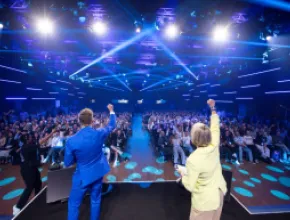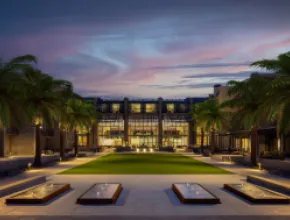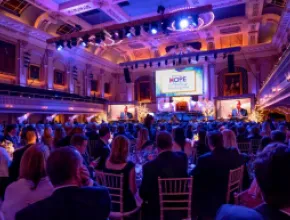By Jan. 9, 2009, the Las Vegas Convention Center will have finished hosting the 2009 Consumer Electronics Show and its estimated 148,000 attendees. That’s at the same time as the Adult Entertainment Expo 2009 descended on the Sands Expo & Convention Center with an additional 37,000 delegates, the Mid-America Auctions annual motorcycle auction dropped 500 more conventioneers on the South Point Casino Hotel & Spa, and The Home Entertainment Show gathered 4,600 people at the Alexis Park Resort.
That’s 190,000 attendees—give or take—all in one day, making Jan. 8 the busiest start date on the 2009 Las Vegas convention calendar.
And is Sin City worried that adding this many visitors—a quantity of business travelers equivalent to the entire population of Fort Lauderdale—might strain a city that’s already busy with the ordinary, everyday tens of thousands of gamblers, vacationers, honeymooners and sightseers?
In a word, no.
“We do that every weekend so that’s no problem! Typically our Januarys look like that,” says Chris Meyer, vice president of convention sales at the Las Vegas Convention and Visitors Authority (LVCVA).
Even more startling is the fact that 83 percent of Las Vegas visitors are leisure-oriented while just 17 percent are business travelers, meaning those 190,000 in town for early-January conferences may be just a fraction of the city’s total visitors, particularly on the weekend. If it’s a holiday weekend, if there’s a high-profile boxing match in town, or even if enough people feel like getting out of Los Angeles or Phoenix on a given day, the number of visitors to Las Vegas swells dramatically.
“Obviously, with a Consumer Electronics Show you would have a higher concentration of business guests,” Meyer says. “But we still have that leisure component.”
“Our business visitors typically come Monday through Thursday, and the leisure visitor is typically a weekend guest, so we flip the switch when we go from the business traveler to the leisure traveler,” he adds.
To many visitors, Las Vegas has come to mean the Strip, the four-mile stretch of Las Vegas Boulevard South that is staked out end-to-end by some of the world’s largest hotels. And they’re not just the largest; they’re meant to impress visitors at every level, from their enormous size to their evocative themes: the Mirage’s volcano, New York New York’s roller coaster and skyline, Paris Las Vegas’ replica Eiffel Tower, the high-rise Rome of Caesars Palace, Luxor’s sleek black pyramid, Mandalay Bay’s tower of glittering gold.
While gambling has fueled Las Vegas growth, the city’s newer casinos have grown into full-scale resorts, adult-oriented “Disney Worlds” where even outsized appetites for live entertainment, food and drink, fine art and spa treatments can be indulged.
To attract spur-of-the-moment and leisure travelers, the LVCVA now runs an ad campaign with the slogan, “Crazy Times Call for Crazy Fun,” a supplement to the now-legendary “What Happens Here Stays Here” campaign that humorously positions Las Vegas as the antidote to people’s hectic workdays, according to Meyer.
“This campaign is, ‘Go to Vegas right now’ and it’s basically giving you permission because we’re all working so hard in crazy times,” he says.
But Las Vegas has a nine-to-five business side, too, and an acute awareness of the value of the meetings dollar. A single hotel—the Wynn Las Vegas, for example—can have 200,000 square feet of meeting space or more, all by itself. And part of the large scale of the hotels here is unrelated to any need to impress; the glitter of roller coasters and pyramids may attract visitors, but then hoteliers need to feed, house and transport them. In the case of meetings and conventions, hotels must also supply meeting and exhibition venues for tens of thousands of people to come and go safely, conveniently and even (in January’s case) simultaneously.
To deal with this crush of humanity, Las Vegas has 136,000 hotel rooms at its disposal and climbing, plus 9.7 million square feet of meeting and exhibit space that is expected to top 10 million when the new Octavius Tower at Caesars Palace opens in mid-2009. Other major hotel construction and renovation, including MGM Mirage’s massive CityCenter project and the $800 million renovation of the Hard Rock Hotel & Casino, will add additional guest rooms, meeting space entertainment options and restaurants to the Las Vegas inventory, which already includes top meetings-ready properties like Caesars Palace, the Palms, Planet Hollywood, Platinum Hotel & Spa, Mandalay Bay and The Venetian, to name just a few.
That doesn’t mean the city sits back and allows people to find Las Vegas. To attract meetings business in an increasingly down economy, Meyer has his sales staff pounding the pavement—hard.
“I have got my entire sales staff out executing 1,000 face-to-face sales calls in 90 days and executing six sales missions where hotels can [come with us to] talk about their individual properties to groups of buyers, both in the leisure and the group markets,” he says. “I think the most important feedback we’re getting from the field is that customers are happy we’re sitting in front of them at their office, listening to their concerns, helping to understand their business.”
Gambling-related businesses and the Strip are so dominant in the Las Vegas cityscape that people sometimes overlook the fact that Las Vegas has a non-Strip downtown with more casinos, such as Binion’s, but the city has also made a serious effort to broaden its economy through efforts such as First Fridays art walks, off-Strip dining and an increasing selection of cultural facilities such as the planned Las Vegas Art Museum.
The city also spent $5.5 million to beautify the streetscape in what has come to be called the Fremont East Entertainment District, a three-block area that is now graced by vintage-looking neon signs that recall Las Vegas’ Rat Pack past.
These complement the Fremont Street Experience, the district created by 10 non-Strip casinos to bolster their fortunes in the face of ever-increasing numbers of Strip resorts. The district is now a highly walkable outdoor zone that frequently features live entertainment and specifically hearkens back to pre-resort Vegas: the 99-cent shrimp cocktails, the classic casinos like Binion’s and the Golden Nugget, and the almost Mardi Gras-like atmosphere on the streets.
Henderson/Lake Las Vegas
Henderson originally began growing during World War II as a site for processing magnesium, then transitioned to supplying rocket fuel to the U.S. government. The stable jobs this industry provided have combined with proximity to Las Vegas to create a prosperous city of about 240,000 that is a combination industrial center, resort area and bedroom community—a mix that inspired Money magazine to peg Henderson at number 20 on its 2006 list of the 100 best places to live in the U.S., and Prevention to name Henderson the sixth-best walking city in the U.S., ahead of even San Diego.
The resorts surrounding 320-acre Lake Las Vegas are major draws for visitors, who can choose from Casino MonteLago, Loews Lake Las Vegas Resort, MonteLago Village Resort and The Ritz-Carlton, Lake Las Vegas. Each of these properties has meeting space, with Casino MonteLago’s being used primarily for weddings.
Henderson itself offers the Henderson Convention Center, which has space for 1,000 theater style; the Henderson Pavilion’s 2,400-seat outdoor amphitheatre; and a variety of hotel properties that complement the high-end venues at Lake Las Vegas. In addition, the Green Valley Ranch Resort offers a combination of meeting space, guest rooms, a casino, a spa and the new Ovation live-entertainment complex.
Summerlin
Summerlin is a southwest suburb of Las Vegas that lies at the western edge of Las Vegas Valley next to the gorgeous Red Rock Canyon Natural Conservation Area. A planned community on land previously owned by Howard Hughes, Summerlin’s several villages straddle both Las Vegas and unincorporated Clark County. It caters to outdoor enthusiasts with excellent access to rock-climbing areas, 150 miles of hiking, biking and running trails, golf courses and other amenities.
Summerlin’s major hotel properties include JW Marriott Las Vegas Resort & Spa, with 65,000 square feet of function space; Red Rock Casino, Resort & Spa, with 70,000 square feet of meeting space; and Suncoast Hotel & Casino, with 25,000 square feet of function space.
Laughlin
Near the southernmost tip of Arizona and strategically placed near the borders of Arizona and California, Laughlin is a world apart from the scale and hustle-bustle of the Las Vegas Strip—so much so that the Visit Laughlin website’s motto is, “It’s Like You Own the Place.”
Of course, Laughlin doesn’t lack for a Harrah’s or a Tropicana for the gambling-minded, but it strives to take advantage of its natural surroundings and welcome families.
“As a gaming destination, we’re not going to actively market ourselves as a family-friendly destination,” says Meg McDaniel, senior manager, regional sales/Laughlin at the Laughlin Visitors Bureau. “But with the kind of place Laughlin is, that [idea] is bestowed on us. It’s a small-town atmosphere. There’s a safety factor there. You just feel like you’re in a much more comfortable, relaxed environment.”
McDaniel adds that families are also likely to see their dollar go a bit further in Laughlin than elsewhere in Nevada, and that the presence of the Colorado River also helps, allowing visitors to engage in outdoor activities such as waterskiing or jet-skiing, and there’s plenty of hiking in the area.
Laughlin’s eight largest hotel and casino properties line the Colorado River, and a riverside walkway connects seven of them. Visitors can also take one of the water taxis that go up and down the Colorado, a scenic way to get back and forth to the town’s various venues.
The Aquarius Casino Resort and Don Laughlin’s Riverside Resort have the most meeting space in town—30,000 and 27,400 square feet, respectively—but the Colorado Belle Hotel/Casino & Microbrewery, Edgewater Hotel & Casino, Harrah’s Laughlin Casino and Hotel, River Palms Resort Casino and Tropicana Express Hotel Casino all have meeting space in addition to guest rooms, helping to boost the city’s total to about 125,000 square feet.
“A group of 75 to 100 in some major cities would get completely lost, but in Laughlin it doesn’t matter if you’re 20, 200 or 500; everyone gets the same personalized attention,” McDaniel says. “And I could pick up the phone and call any of the hotels and say I need something to happen, and they make it happen.
“We often send people to Oatman, Arizona, across the border” she adds. “It’s a step back into the Old West with gunfights in the streets. It’s also part of Route 66, and families like that step-back-in-time feel.”
Casino Drive is Laughlin’s answer to the Las Vegas Strip, and the 1.75-mile-long road will get new landscaping starting this year.
Laughlin plans to construct a trail system that would extend across the Laughlin Bridge into Arizona and all the way to the Davis Dam, creating a two-mile-long interpretive trail. This is in keeping with Laughlin’s attempts to branch out beyond its traditional family market to more upper-income visitors, such as birders.
“We’re a great destination for birding; [until recently] we didn’t realize we have over 300 types of birds that come to the area. Casual birders are typically upper-income and have higher education levels, and we’re just trying to get the message out that Laughlin is a place where you can enjoy that hobby,” McDaniel says.
Mesquite
Eighty miles northeast of Las Vegas next to the Arizona border, Mesquite is a popular resort and retirement area of just under 10,000 residents. This former farming community now has five casino hotels, several of which cater to meetings, and a location close to some of the most famed sites in the Southwest: Zion and Bryce national parks to the northeast, the Grand Canyon to the southeast and Hoover Dam, Lake Mead and Las Vegas to the southwest. Its position astride Interstate 15 makes it a natural stopping point for traffic between Los Angeles, Las Vegas and Salt Lake City, while its distance from any of those places ensures a certain amount of laid-back tranquility.
The city offers its own championship golf courses and a fine arts center, and is just a short drive from St. George, Utah, site of the annual Utah Shakespearean Festival.
Mesquite’s five casino hotels include the CasaBlanca Hotel, Eureka Casino Hotel, Oasis Resort Casino, Stateline Casino and Motel, and Virgin River Hotel.
Primm
Primm takes advantage of being the first town on the Nevada side of the California-Nevada border to offer gambling-hungry Californians a casino warm-up before they get to Las Vegas—or hand a last chance to gamble to the homeward-bound. It’s the home of Buffalo Bill’s and Whiskey Pete’s casinos as well as the less Western-themed Primm Valley Resort, which all share the same ownership and have a 21,000-square-foot conference center, a 6,000-seat arena, a 700-seat auditorium and 10 restaurants among them.
Interestingly, Primm has repeatedly been the site of the DARPA Grand Challenge, a government-sponsored point-to-point race for fully automatic, unmanned vehicles.
For More Info
Henderson Convention Center and Visitors Bureau 702.267.2171 www.visithenderson.com
Las Vegas Convention and Visitors Authority 702.892.0711 www.lvcva.com
Laughlin Visitors Bureau 702.298.3022 www.visitlaughlin.com






